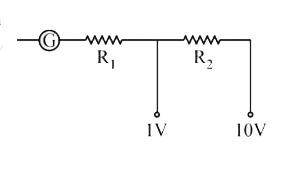The resistance of a moving coil galvanometer is 20Ω. It requires 0.01 A current for full - scale deflection. The value of resistance to convert it into a voltmeter of the range 20 V will be
198Ω
1980Ω
20Ω
0Ω
The correct Answer is:B
To solve the problem of converting a moving coil galvanometer into a voltmeter, we need to determine the additional resistance required in series with the galvanometer. Here’s a step-by-step solution:
Step 1: Understand the Given Data
- The resistance of the galvanometer (G) = 20 Ω
- The current required for full-scale deflection (I_G) = 0.01 A
- The desired voltage range for the voltmeter (V) = 20 V
Step 2: Use Ohm's Law
To convert the galvanometer into a voltmeter, we need to find the total resistance (R_total) required for the voltmeter to measure up to 20 V with the specified current.
Using Ohm's Law:
V=I⋅Rtotal
Where:
- V is the voltage across the voltmeter.
- I is the current through the circuit (which is the same as I_G for full-scale deflection).
- Rtotal is the total resistance of the circuit (which is the sum of the galvanometer resistance and the additional resistance).
Step 3: Calculate Total Resistance
From the equation, we can express Rtotal as:
Rtotal=VIG
Substituting the known values:
Rtotal=20V0.01A=2000Ω
Step 4: Calculate the Additional Resistance
The total resistance required for the voltmeter is the sum of the galvanometer resistance and the additional resistance (R):
Rtotal=R+G
Rearranging gives us:
R=Rtotal−G
Substituting the values we have:
R=2000Ω−20Ω=1980Ω
Step 5: Conclusion
The value of the resistance required to convert the galvanometer into a voltmeter of range 20 V is:
R=1980Ω
Final Answer
The required resistance is 1980 Ω.
---
- The resistance of the galvanometer (G) = 20 Ω
- The current required for full-scale deflection (I_G) = 0.01 A
- The desired voltage range for the voltmeter (V) = 20 V
To convert the galvanometer into a voltmeter, we need to find the total resistance (R_total) required for the voltmeter to measure up to 20 V with the specified current.
V=I⋅Rtotal
- V is the voltage across the voltmeter.
- I is the current through the circuit (which is the same as I_G for full-scale deflection).
- Rtotal is the total resistance of the circuit (which is the sum of the galvanometer resistance and the additional resistance).
From the equation, we can express Rtotal as:
Rtotal=VIG
Rtotal=20V0.01A=2000Ω
The total resistance required for the voltmeter is the sum of the galvanometer resistance and the additional resistance (R):
Rtotal=R+G
R=Rtotal−G
R=2000Ω−20Ω=1980Ω
The value of the resistance required to convert the galvanometer into a voltmeter of range 20 V is:
R=1980Ω
The required resistance is 1980 Ω.
Similar Questions
The resistance of a galvanometer is 10Ω. It gives full-scale deflections when 1mA current is passed. The resistance connected in series for converting it into a voltmeter of 2.5V will be
View SolutionA galvanometer having resistance of 50Ω requires a current of 100ΩA to given full scale deflection. How much resistance is required to convert it into an ammeter of range of 10 A ?
View Solution
Knowledge Check
The resistance of a galvanometer is 10Ω. It gives full-scale deflections when 1mA current is passed. The resistance connected in series for converting it into a voltmeter of 2.5V will be
A24.9ΩB249ΩC2490ΩD24900Ω
When a current of 5mA is passed through a galvanometer having a coil of resistance 15Ω, it shows full sacle deflection. The value of the resistance to be put in series with the galvanometer to convert it into a voltmeter of range 0−10V is:
View SolutionThe resisitance of a galvanometer is 50Ω and it shows full scale diflection for current of 1 mA. . To convert it into a voltmeter to measure 1V and as well as 10 V ( refer circuit diagram ) the resistance R1 and R2 respecivtively

View SolutionThe resistance of galvanometer is g ohm and the range is 1 volt. The value of resistance used to convert it into a voltmeter of ragne 10 volt is:-
View SolutionA galvanometer of resistance 16 ohm shows full scale deflection for a current of 4 mA. How will you convert it into a voltmeter to measure voltage up to 3 V?
View SolutionA galvanometer of resistance 100Ω gives full deffection for a current 10−5 the value of shunt required to convert it into ammeter of range 1 ampere is:-
View SolutionThe full scale deflection current of a galvanometer of resistance 1Ω is 5mA. How will you convert it into a voltmeter of range of 5V?
View SolutionA galvanometer coil has a resistance of 990Ω and it shows full scale deflection for a current of 10mA. Calculate the value of resistance required to convert it into an ammeter of range 1 A.
View Solution
